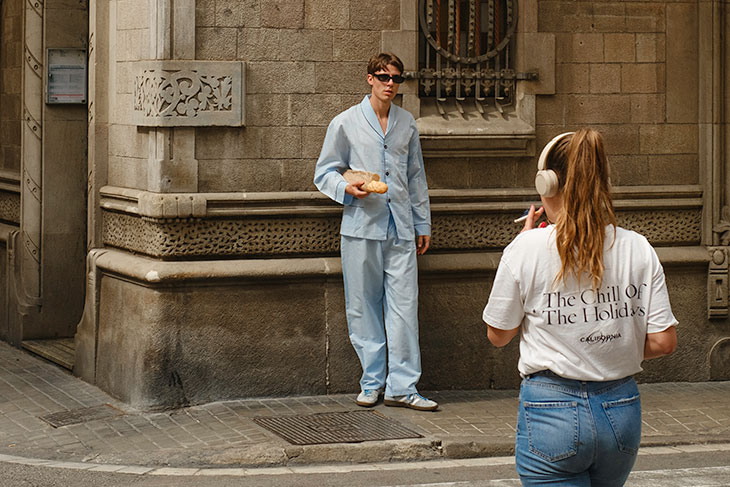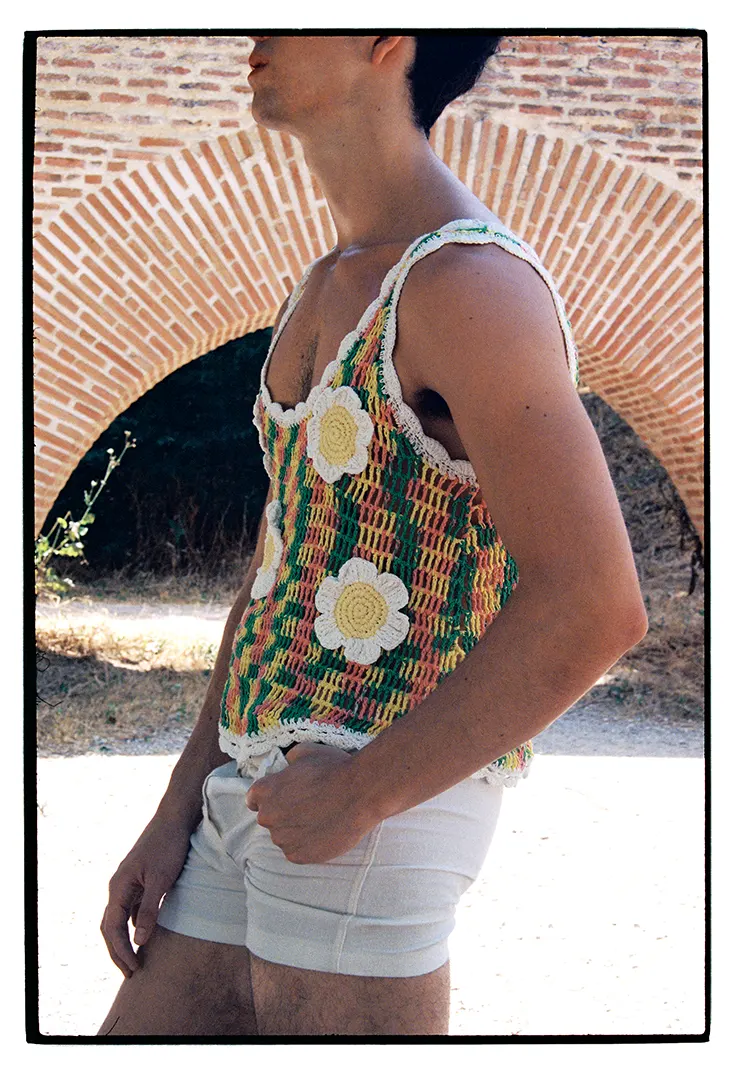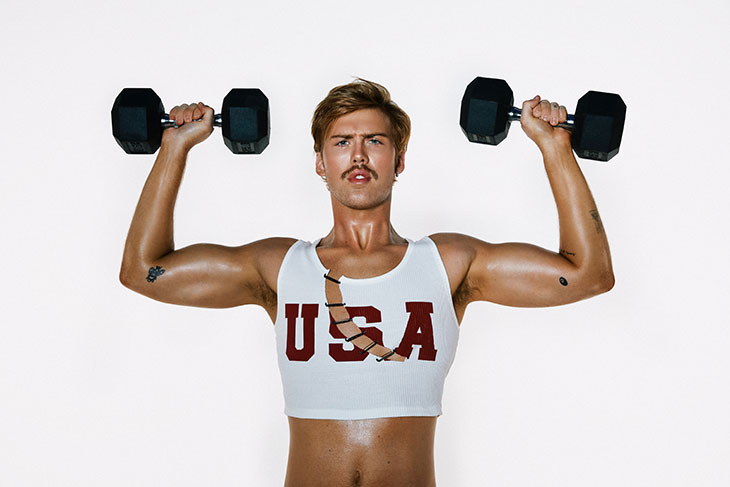
The performative male does not exist in nature. He is a construct, built in the glow of the front-facing camera. He treats his own reflection as a part-time job and his Instagram grid as a résumé. The point is not to live but to signal life, to gesture toward taste, to cultivate the impression of having read more than the caption requires. To matter, he must be seen, and to be seen, he must perform.
DORIC ORDER
The uniform is never random. Acne Studios trousers, Loewe knits, a Prada nylon bag slung over the shoulder, CELINE sunglasses angled just so. The labels matter, because they speak the language of recognizability. Clothes become captions: a soft cashmere cardigan says sensitivity, a perfectly distressed leather jacket says danger. It’s costume design, with the body as stage. The Trader Joe’s tote bag carries Joan Didion’s Blue Nights or Sally Rooney’s Normal People, books that photograph well, books that say “I am reflective, but accessible.” He reads them, or at least he wants to be seen holding them.

The performance does not stop with fashion. Grooming is content. The beard must stay in its three-day zone, never too scruffy, never too precise. Skincare is narrated like confession: serums, retinols, sunscreen. Even sleep gets tracked, displayed, folded back into the performance of balance. Life turns into a spreadsheet with a face.
What makes the performative male possible is an economy that monetizes personality. He is both subject and commodity. A body photographed in the gym is a personal victory, but also a lure for partnerships. The morning matcha can be sponsored. The book held in frame doubles as affiliate link. Vulnerability, packaged as caption, becomes another form of currency.
The performative male does not exist in nature. He is a construct, built in the glow of the front-facing camera.
The man himself may not notice the full shift. He thinks he is documenting life, but the logic runs in reverse. Life gets curated to produce documentation. Dinner with friends is a new unpaid internship for the brand of himself. Each image asks: how will this play? Intimacy is structured as outreach, spontaneity rehearsed in the shadow of a ring light.
Traditional masculinity once required silence. Men were expected to prove themselves through labor, control, and withdrawal. Emotional expression marked weakness, visibility marked vanity. The performative male inverts that script. He thrives on exposure. His value lies in making emotion legible, in presenting his body as evidence of discipline, in narrating his pain so that others can validate it. Where stoicism worked in private, sincerity now demands an audience.

But this sincerity is staged. His vulnerability arrives as a cinematic close-up. He confesses loneliness in one post and in the next offers discount codes for supplements. The act of care, therapy, meditation, “softness,” becomes branding, stripped of its difficulty, polished for consumption. Sincerity becomes aesthetic.
No arena reveals this more clearly than fitness. The gym has become a stage where men rehearse strength for an imagined audience. The mirror is no longer functional, it is ceremonial. Progress shots, lighting, the calculated flex, each is part of a continuous feed of proof. The male body has always been policed, but now it is commercialized with relentless intensity. A six-pack is cultural currency.
Algorithms reward exposure, brands monetize it, and men adapt.
The danger lies in the shift from exercise as health to exercise as evidence. When the body functions as billboard, eating and training no longer serve the self but the persona. Rest loses value. Fatigue must be edited out. The man becomes less a body than a campaign: toned, lit, and optimized.
Performance thrives on contrast, so the performative male does not only present strength. He stages softness, too. A crying selfie. A caption about therapy. A book of poetry left on the table just visible in frame. Vulnerability sells now, and he has noticed. But the act comes stripped of the stakes. It gestures toward fragility while remaining safe, digestible, and always in service of visibility.

What results is a loop where the only authentic act is self-exposure. If you are not seen to suffer, the suffering does not count. If you are not seen to care, the care does not matter. Intimacy loses its privacy, collapsing into content.
It is easy to mock the performative male. The tote, the iced matcha, the mirror selfie, the Rooney paperback, it all seems laughable in its predictability. But the joke ignores the structure. He performs because the culture demands performance. Algorithms reward exposure, brands monetize it, and men adapt. Old masculinity no longer guarantees status. Provider roles crumble in economies of precarity. Silent stoicism does not travel in the feed. To stay relevant, he must act. He must curate. He must prove. He exists because we built the theater around him.
He reveals the collapse of traditional scripts for masculinity and the failure to offer new ones that value substance over optics.
The cost is interior life. When performance becomes constant, the private dissolves. The man loses his own backstage. He struggles to separate what he enjoys from what he documents. Reading becomes pose. Friendship becomes grid. Love becomes content. Without a backstage, exhaustion sets in. He keeps posting even when hollow, because silence no longer feels safe. He has trained his audience to expect him, and absence reads like failure.
The performative male is a cultural weather report. He tells us what the system rewards: bodies as proof, books as branding, vulnerability as marketing, life as performance. He reveals the collapse of traditional scripts for masculinity and the failure to offer new ones that value substance over optics. He shows us how far visibility has colonized the self, and how masculinity, like everything else, has been bent into spectacle.

What would refusal look like? It might look like keeping some things off-camera. Reading without posting. Training without tracking. Crying without caption. Refusal would also mean interrogating the economy that profits from insecurity. The supplements, the skincare, the endless protocols: each feeds on the idea that men are never enough. Refusal punctures the loop by naming it. You are not unfinished. You are not a campaign. You do not need to prove worth with every gesture.
The performative male cannot vanish overnight. He will keep posing in his Loewe knit with Rooney in hand, because the culture still rewards it. But there is room for another script. Care that is unposted. Strength that is unadvertised. Intimacy that is unmeasured.
Vulnerability sells now, and he has noticed.
The alternative is not a return to silence. Silence was always brittle. The alternative is a space where men can exist without the constant audition, where identity is not a marketing plan, where proof is unnecessary. That space requires culture to stop rewarding performance and start valuing substance, difficult, unphotogenic, and therefore real.
Until then, the performative male will keep rehearsing his lines. He will keep sipping matcha, quoting Maggie Nelson, flexing in Acne, confessing to therapy in captions. The show goes on, because the audience has not left the room.




















